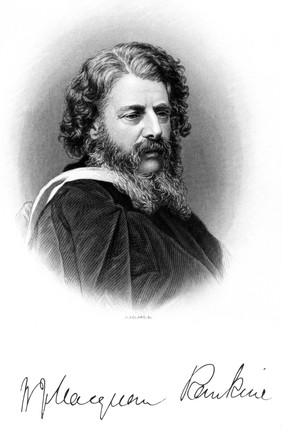
William John Macquorn Rankine (1820-1872)
On July 5, 1820, Scottish mechanical engineer William John Macquorn Rankine was born. He was a founding contributor, with Rudolf Clausius and William Thomson (Lord Kelvin), to the science of thermodynamics, particularly focusing on the first of the three thermodynamic laws.
“Discrepancy between theory and practice, which in sound physical and mechanical science is a delusion, has a real existence in the minds of men; and that fallacy, through rejected by their judgments, continues to exert and influence over their acts.”
— William John Macquorn Rankine, “Introductory Lecture on the Harmony of Theory and Practice in Mechanics” (1856), p. 4
Leaving University to Apprentice to an Engineer
Born in Edinburgh as second son to British Army lieutenant David Rankine and Barbara Grahame, Rankine was due to bad health initially educated at home in a strictly religious environment. Rankine‘s interests were divided between music and mathematics. Later he attended Ayr Academy and, very briefly, the High School of Glasgow. Around 1830 the family moved to Edinburgh and in 1834, Rankine studied at a Military and Naval Academy with the mathematician George Lees, followed by the study a spectrum of scientific topics at the University of Edinburgh in 1838, including natural history. During vacations, he assisted his father who, from 1830, was manager and, later, effective treasurer and engineer of the Edinburgh and Dalkeith Railway which brought coal into the growing city. Rankine decided not to take a university degree but chose to leave university and become an apprentice to the engineer John Benjamin MacNeill, perhaps because of straitened family finances. Sir John Benjamin Macneill was at the time surveyor to the Irish Railway Commission, involved with, including river improvements, waterworks, railways and both harbours. During his pupilage Rankine developed a technique, later known as Rankine‘s method, for laying out railway curves, fully exploiting the theodolite and making a substantial improvement in accuracy and productivity over existing methods. In fact, the technique was simultaneously in use by other engineers – and in the 1860s there was a minor dispute about Rankine‘s priority.
The Phenomena of Heat
The year 1842 also marked Rankine‘s first attempt to reduce the phenomena of heat to a mathematical form. Probably his interest in heat and heat engines developed from his early work with railroads. Though his theory of circulating streams of elastic vortices whose volumes spontaneously adapted to their environment sounds fanciful to scientists formed on a modern account, by 1849, he had succeeded in finding the relationship between saturated vapour pressure and temperature. The following year, he used his theory to establish relationships between the temperature, pressure and density of gases, and expressions for the latent heat of evaporation of a liquid. He accurately predicted the surprising fact that the apparent specific heat of saturated steam would be negative, which was later confirmed experimentally. Rankine then began to generalize his equations to include solids and liquids. Suggesting that his previous equations were probably valid only for perfect gases, he removed any restrictions on the shape of the atoms and vortices, except to demand that the matter in the vortices move in closed paths. By clever approximations, Rankine obtained the same equations as before and immediately concluded that they therefore applied to all substances, whether in the solid, gaseous, or liquid state.[3]
The Efficiency of Heat Engines
At this time Rankine turned his attention to the problem of calculating the efficiency of heat engines. Like Clausius [4] and William Thomson,[5] who had been working independently on the theory of heat, Rankine attempted to derive Carnot’s law.[6] Rankine used his theory as a basis to deduce the principle, that the maximum efficiency possible for any heat engine is a function only of the two temperatures between which it operates. Though a similar result had already been derived by Rudolf Clausius and William Thomson, Rankine claimed that his result rested upon his hypothesis of molecular vortices alone, rather than upon Carnot‘s theory or some other additional assumption. The work marked the first step on Rankine‘s journey to develop a more complete theory of heat. He developed a general theory of energy that was independent of all mechanical hypotheses. The sum of the actual and potential energies of the universe was assumed constant—a law already familiar as the conservation of energy. Rankine then proposed a law that determined the amount of energy transformed during any change of state of a substance. By 1855, Rankine had formulated a science of energetics which gave an account of dynamics in terms of energy and its transformations rather than force and motion. The theory was very influential in the 1890s. In 1859 he proposed the Rankine scale of temperature, an absolute or thermodynamic scale whose degree is equal to a Fahrenheit degree.
Pioneering Research in Thermodynamics
“This law (regarding the theoretical efficiency of heat engines by Mr. Joule), and the law of the maximum efficiency of heat engines, are particular cases of a general law which regulates all transformation of energy, and is the basis of the Science of Energetics.”
– William John Macquorn Rankine, Manual of Applied Mechanics, (1858)
In 1855, Rankine was appointed to the Queen Victoria chair of civil engineering and mechanics at the University of Glasgow. Rankine conducted pioneering research in the fields of railway engineering, molecular physics and thermodynamics. He wrote more than 150 scientific papers and manuals as well as textbooks which became standard works of reference for students. Rankine also developed methods for calculating the distribution of forces (statics) in frame constructions, investigated the stability of walls in civil engineering, the design and hydrodynamics of ships, and wrote about the material fatigue of metals, e.g. in locomotive axles. In soil mechanics there is an earth pressure calculation according to Rankine. According to Rankine’s earth pressure theory (“Rankine’s special case”) the course of the earth pressure on walls is calculated with the help of the active and passive earth pressure, whereby the wall friction angles are zero, which represents a computational simplification. In 1849 he became a member of the Royal Society of Edinburgh, and in 1853 Rankine became a member of the Royal Society in London. He was a member of the Royal Swedish Academy of Sciences and the American Academy of Arts and Sciences (1866). In 1857 he received an honorary doctorate from Trinity College in Dublin.
The Rankine Scale
In 1859, he proposed a temperature scale. The Rankine scale is a temperature scale that, like the Kelvin scale, has its zero value at absolute temperature zero, but uses the scale spacing of the Fahrenheit scale as opposed to the Kelvin scale. The distance of one degree Rankine (unit sign: °Ra or restricted °R) is equal to the difference of one degree Fahrenheit, but the absolute zero point is 0 degree Rankine or -459.67 degree Fahrenheit. Degrees Rankine is not an SI unit. The Rankine scale was mainly used in English-speaking countries.
John William Macquorn Rankine died on 24 December 1872 at age 52.
William Rankine Memorial Lecture, [10]
References and Further Reading:
- [1] William John Macquorn Rankine Biography at Mac Tutor History
- [2] William John Macquorn Rankine, Scottish engineer, at Britannica Online
- [3] “Rankine, William John Macquorn.” Complete Dictionary of Scientific Biography. 2008.
- [4] Rudolf Clausius and the Science of Thermodynamics, SciHi Blog
- [5] Lord Kelvin and the Analysis of Thermodynamics, SciHi Blog
- [6] Nicolas Sadi Carnot and the Science of Thermodynamics, SciHi Blog
- [7] William John Macquorn Rankine at Wikidata
- [8] William John Macquorn Rankine, Outlines of the Science of Energetics (1855), Proceedings of the Royal Philosophical Society of Glasgow, Volume 3, by Royal Philosophical Society of Glasgow, 1855. pp.121-141.
- [9] Works by or about William John Macquorn Rankine at Internet Archive
- [10] William Rankine Memorial Lecture, The Master Engineer, Professor Gordon Masterton on the legacy to Civil Engineering of William John MacQuorn Rankine, The Worshipful Company of Engineers @ youtube
- [11] Timeline of Thermodynamicists, via DBpedia and Wikidata






Pingback: Whewell’s Gazette: Year #2 Vol. #01 | Whewell's Ghost
Pingback: Whewell’s Gazette: Year 3, Vol. #47 | Whewell's Ghost